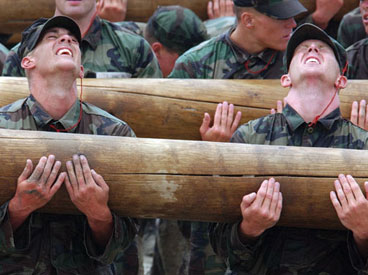
Use of released U.S. Navy imagery does not constitute product or organizational endorsement of any kind by the U.S. Navy.
Photo by photographer’s Mate 2nd Class Eric S. Logsdon.
Hell Week isn’t designed to kill you. It’s designed to make you wish you were dead—or at least to push you to the edge of physical and mental endurance to see how you react. While the demands are mostly physical, the journey through them is all about mental attitude.
Just the thought of what was coming was too much for some guys.
The Sunday night before Hell Week, the instructors put us to bed early in 50-man canvas tents on the beach. The wind was picking up. Sand was blowing around. I don’t think anyone got much sleep at all. Lying in the darkness, imagining how brutal the next five days would be, a couple of my classmates made life-changing decisions right then and there. They didn’t say a word to anyone. They just climbed off their cots and hurried out of the tent. Soon enough, the bell was ringing again. No one tried to stop them. If you’re quitting in the tent, there’s no way this is for you.
In the second decade of America’s war on terror, conventional military methods just aren’t getting it done anymore. After Vietnam, Iraq, and Afghanistan, America’s top leaders keep asking what works, what doesn’t and why. Sometimes the answer is drones. But more and more often, the response is: “Send in the SEALs.” Small, nimble units of highly trained warriors, we are experts at missions that traditional armies were never built for. Lightning-quick commando raids. Highly orchestrated assaults. Discreet operations in challenging environments. Extractions, recoveries, and other bold maneuvers that don’t even have names yet. It’s an amazing run we’ve been on since 9/11. And it all starts with our legendary basic training program. Seventy-five percent of the fresh recruits don’t make it past Hell Week.
My Hell Week, like all Hell Weeks, arrived with a bang. Literally.
First, we heard some rustling outside the tent.
Then—ka-boom!
Someone tossed a simulation grenade right next to my cot. Suddenly three or four instructors were rushing frantically around, kicking sand, shouting and firing Mk 48 machine guns. The weapons were loaded with blanks. But they were painfully loud, and they were spewing round after round of sizzling hot brass. The shell casings were bouncing everywhere, including down the backs of people’s uniform tops. It was a full, five-sense overload in there—whistles blowing, sirens wailing, smoke billowing everywhere—the worst wake-up call ever. Groggy and disoriented, my classmates and I leaped out of our cots and onto our feet. This was Breakout, evolution number one of Hell Week.
“Hit the surf!” one of the instructors shouted, and we all went running for the frigid Pacific. That run was damn near the last time any of us was dry or warm all week.
The instructors called us out of the surf, split us into our boat crews, and ushered us onto the Grinder, which had been transformed into the Southern California version of a live-action urban fire zone. The grenades were going off in all four corners. Smoke bombs choked the square with an acrid haze while huge fire hoses sprayed mist on everyone. A .50-caliber, tripod-mounted machine gun was on the rooftop, blasting away. Instructors were back with their Mk 48s, still spewing brass. The cadre had set up what looked like carnival stations around the Grinder with special challenges at each one. The boat crews moved through the smoke together, locking arms so we didn’t lose anyone, performing bursts of flutter kicks, pushups, squats, jumping jacks, low crawls, and buddy drags.
Then came the shout, “Surf torture!”—and we headed back to the water again.
“Lock arms!” the instructor demanded as we linked ourselves in a long human chain of interlocked elbows. We clenched our hands together in front of us.
“Forward march!”
We marched together into the surf. It couldn’t have been more than 52 or 53 degrees in there. We walked farther out until the water was chest-high on most of us.
“Halt!” the instructor said.
Then “Take seats!”
That’s where the real torture began. We floated along in this armlocked line, bouncing in the rough surge of the Pacific, catching breaths when we could, as the constant waves smashed over our heads.
Boom, boom, boom. The waves kept breaking over us.
With all the strength we had, we were holding on to each other and trying to keep our heads up in the great wash cycle of the Pacific as our battered bodies were tossed helplessly around. Water was rushing over us, into our eyes, mouths, and noses. Sand and sea life were in the whirling mix. It was a hugely disorienting experience.
And that was the point. Seeing if we could keep our cool instead of panicking. Trusting our fellow students to help hold us upright. Going with the flow to ride out the surf. Building the cohesiveness that we would eventually carry with us to the battlefield.

Hell Week hasn’t changed much over the years. “Surf torture” is now officially renamed “surf immersion,” which I guess is more politically acceptable. But most students still use the old name, and believe me, the experience is every bit as torturous as before. You end up with just as much sand and salt water in your eyes, ears, nose, and mouth. But class after class, those first killer days of Hell Week are when the largest concentration of people quit.
On Monday night, the instructors lined us up single file and marched the whole class onto a mammoth steel-and-concrete pier that extended 75 yards or so into San Diego Bay.
Here we go, I thought to myself as I stood with the others on the pier in our green uniform pants and tops. I’d heard about this. We all had. “Steel pier” was legendary.
We began on the concrete part of the pier. Placed every five paces was a fat fire hose and giant industrial fan like you might see spraying mist from the sidelines of a high school football game on a hot Friday night. It definitely wasn’t hot on that pier.
They marched us onto the steel grating that led to the water.
“Enter,” one of the instructors called. He seemed to mean it. Like a long line of giant lemmings, we jumped one at a time off the edge of the pier and into the bay.
The water was deep there, easily over our heads. The water temperature was a degree or two warmer than the open ocean, but certainly no more than 55 or 56 degrees. I knew if we stayed in that water long enough, our body temperatures would fall so low, we’d all get hypothermia. How long were they keeping us there? We didn’t know if there was a time limit. We didn’t know if they were waiting for the first student to drown. But guys started quitting the program after a minute or two.
Become a Saturday Evening Post member and enjoy unlimited access. Subscribe now



